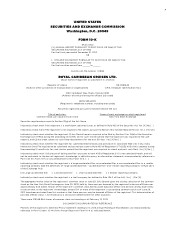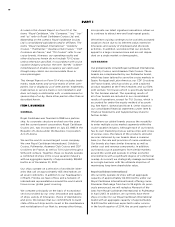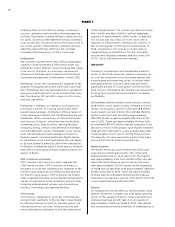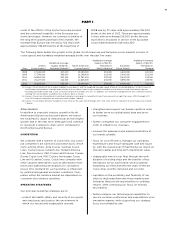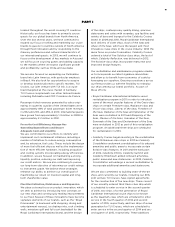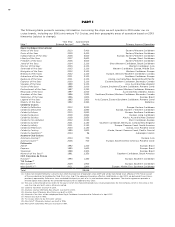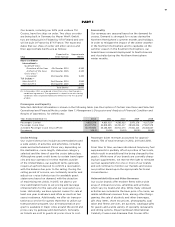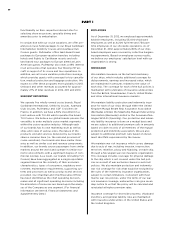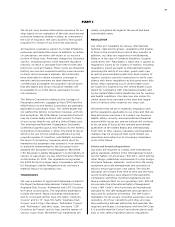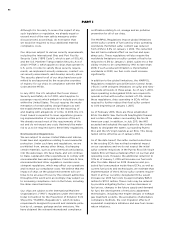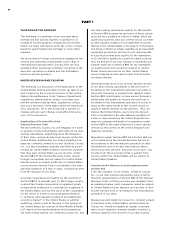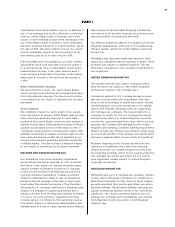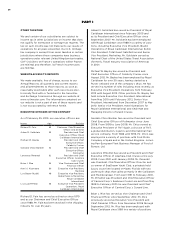Royal Caribbean Cruise Lines 2012 Annual Report Download - page 20
Download and view the complete annual report
Please find page 20 of the 2012 Royal Caribbean Cruise Lines annual report below. You can navigate through the pages in the report by either clicking on the pages listed below, or by using the keyword search tool below to find specific information within the annual report.
16
are expected to increase our passenger capacity by
approximately 18,600 berths by December 31, 2016,
or approximately 18.9%, as compared to our capacity
as of December 31, 2012. We continuously evaluate
opportunities to order new ships, purchase existing
ships or sell ships in our current fleet.
In support of our maintenance programs, we own a
40% interest in a ship repair and maintenance facility,
Grand Bahama Shipyard Ltd., which is the largest
cruise ship dry-dock repair facility in the world and
is located in Freeport, Grand Bahama. We utilize this
facility, among other ship repair facilities, for our reg-
ularly scheduled drydocks and certain emergency
repairs as may be required. In addition, the facility
serves unaffiliated cruise and cargo ships, oil and gas
tankers, and offshore units.
Markets and Itineraries
In an effort to penetrate untapped markets, diversify
our consumer base and respond to changing economic
and geopolitical market conditions, we continue to
seek opportunities to optimally deploy ships to new
and stronger markets and itineraries throughout the
world. The portability of our ships and our invest-
ment in infrastructure allows us to expand into new
markets and helps us reduce our dependency on any
one market by allowing us to create “home ports”
around the world. In addition, it allows us to readily
deploy our ships to meet demand within our existing
cruise markets.
Our ships offer a wide selection of itineraries that call
on approximately 455 ports in 95 countries, spanning
all seven continents. We are focused on obtaining the
best possible long-term shareholder returns by operat-
ing in established markets while growing our presence
in developing markets. New capacity allows us to
expand into new markets and itineraries. Our brands
have expanded their mix of itineraries while strength-
ening our ability to penetrate the Asian, Caribbean,
European, and Latin American markets further. In
addition, in order to capitalize on the summer season
in the Southern Hemisphere and mitigate the impact
of the winter weather in the Northern Hemisphere,
our brands have increased deployment to Australia
and Latin America.
We continue to focus on the acceleration of Royal
Caribbean International’s, Celebrity Cruises’ and
Azamara Club Cruises’ strategic positioning as global
cruise brands. In 2012, Royal Caribbean International
continued its global expansion by seasonally adding
a second ship in Asia and a third ship in Australia,
adding new departure ports in Southern Europe in
order to target guests in key source markets in the
region and increasing capacity in Northern Europe.
The brand also modified certain of its itineraries for
2012 due to continuing geopolitical unrest in Northern
Africa and Greece. In 2013, Monarch of the Seas
will be redeployed to the Pullmantur fleet and Royal
Caribbean International will decrease its European
capacity by approximately 23% in order to mitigate
its exposure to the uncertain outlook in the European
market. Royal Caribbean International will continue
to offer short Bahamas sailings, return to year-round
southern Caribbean sailings and increase capacity in
Asia and China with the repositioning of Mariner of
the Seas.
In October 2012, Celebrity Cruises introduced Celebrity
Reflection, the fifth and final Solstice-class ship, which
offers sailings in Europe and the Caribbean. The addi-
tion of Celebrity Reflection allows Celebrity Cruises to
introduce a Solstice-class ship in Alaska and Australia/
New Zealand, offer a British Isles/Northern European
program, and an Asia program for 2013. The added
product offerings in Europe result in a 12% capacity
increase for 2013. Celebrity Cruises is expanding its
focus on destination by emphasizing exotic ports
and calling on new destinations in Australia and New
Zealand, Hawaii, the Panama Canal and Asia, with
longer cruises in Southeast Asia, Indonesia, China
and Japan.
In 2013, Azamara Club Cruises’ voyages will be sailing
to 184 ports in 60 countries around the globe with
more than 50% of its ports-of-call featuring late night
stays or overnights, allowing guests to experience the
destination by day and by night. The Azamara Club
Cruises 2013 deployment features South America,
including Carnival in Rio de Janeiro, Antarctica,
the West Indies, British Isles and Western Europe,
Scandinavia and the Baltics, Eastern & Western
Mediterranean, as well as the Indian Ocean and Asia.
Also, Pullmantur and CDF Croisières de France will
continue to offer itineraries in the Caribbean, Europe
and South America with particular emphasis in Brazil.
In an effort to secure desirable berthing facilities
for our ships, and to provide new or enhanced cruise
destinations for our guests, we actively assist or invest
in the development or enhancement of certain port
facilities and infrastructure, including mixed-use com-
mercial properties, located in strategic ports of call.
Generally, we collaborate with local, private or gov-
ernmental entities by providing management and/or
financial assistance and often enter into long-term
port usage arrangements. Our participation in these
efforts is generally accomplished via investments with
the relevant government authority and/or various
other strategic partners established to develop and/
or operate the port facilities, by providing direct
development and management expertise or in certain
limited circumstances, by providing direct or indirect
financial support. In exchange for our involvement,
we generally secure preferential berthing rights for
our ships.
PART I



